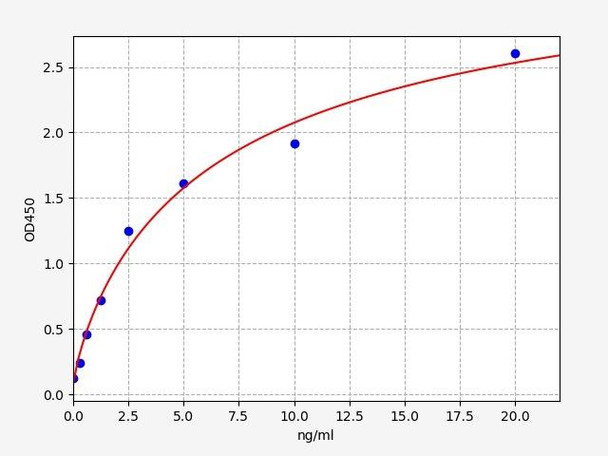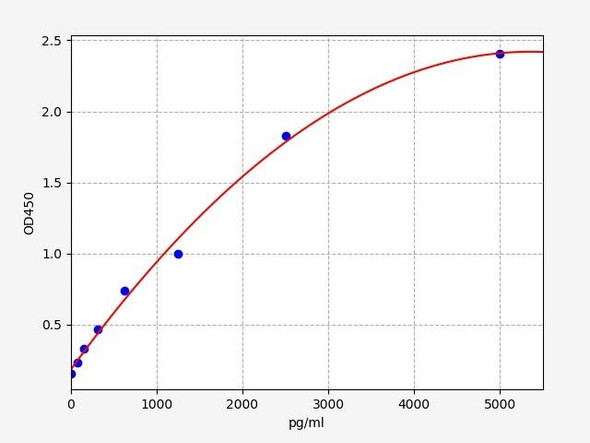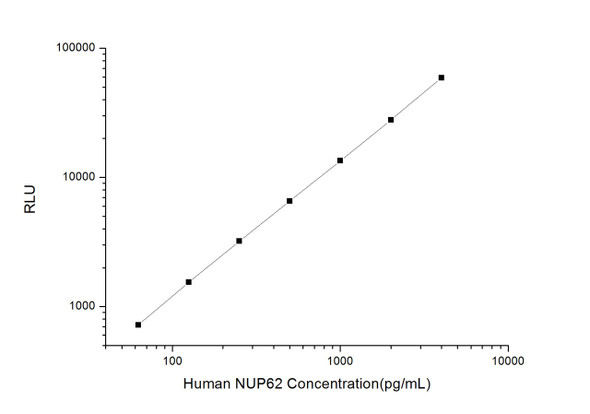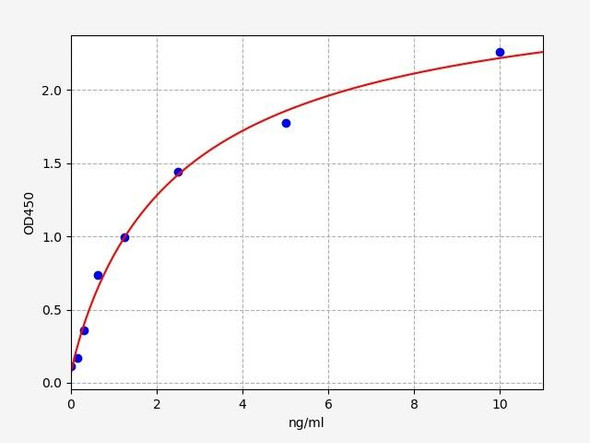Description
Human Nucleoporin p62 / NUP62 ELISA Kit
Nucleoporin p62 / NUP62 extends across the nuclear envelope, forming a channel that regulates the flow of macromolecules between the nucleus and the cytoplasm. Nucleoporin p62 / NUP62 associates with the importin alpha/beta complex which is involved in the import of proteins containing nuclear localization signals. Diseases associated with Nucleoporin p62 / NUP62 include Infantile Striatonigral Degeneration, and Familial Infantile Bilateral Striatal Necrosis.
| Product Name: | Human Nucleoporin p62 / NUP62 ELISA Kit |
| Product Code: | HUFI02678 |
| Size: | 96 Assays |
| Alias: | NUP62 |
| Detection method: | Sandwich ELISA, Double Antibody |
| Application: | This immunoassay kit allows for the in vitro quantitative determination of Human NUP62 concentrations in serum plasma and other biological fluids. |
| Sensitivity: | 0.188ng/ml |
| Range: | 0.313-20ng/ml |
| Storage: | 4°C for 6 months |
| Note: | For Research Use Only |
| Recovery: | Matrices listed below were spiked with certain level of Human NUP62 and the recovery rates were calculated by comparing the measured value to the expected amount of Human NUP62 in samples. | ||||||||||||||||
| |||||||||||||||||
| Linearity: | The linearity of the kit was assayed by testing samples spiked with appropriate concentration of Human NUP62 and their serial dilutions. The results were demonstrated by the percentage of calculated concentration to the expected. | ||||||||||||||||
| |||||||||||||||||
| CV(%): | Intra-Assay: CV<8% Inter-Assay: CV<10% |
| Component | Quantity | Storage |
| ELISA Microplate (Dismountable) | 8×12 strips | 4°C for 6 months |
| Lyophilized Standard | 2 | 4°C/-20°C |
| Sample/Standard Dilution Buffer | 20ml | 4°C |
| Biotin-labeled Antibody(Concentrated) | 120ul | 4°C (Protect from light) |
| Antibody Dilution Buffer | 10ml | 4°C |
| HRP-Streptavidin Conjugate(SABC) | 120ul | 4°C (Protect from light) |
| SABC Dilution Buffer | 10ml | 4°C |
| TMB Substrate | 10ml | 4°C (Protect from light) |
| Stop Solution | 10ml | 4°C |
| Wash Buffer(25X) | 30ml | 4°C |
| Plate Sealer | 5 | - |
Other materials and equipment required:
- Microplate reader with 450 nm wavelength filter
- Multichannel Pipette, Pipette, microcentrifuge tubes and disposable pipette tips
- Incubator
- Deionized or distilled water
- Absorbent paper
- Buffer resevoir
| Uniprot | P37198 |
| UniProt Protein Function: | NUP62: Essential component of the nuclear pore complex. The N- terminal is probably involved in nucleocytoplasmic transport. The C-terminal is probably involved in protein-protein interaction via coiled-coil formation and may function in anchorage of p62 to the pore complex. Defects in NUP62 are the cause of infantile striatonigral degeneration (SNDI); also known as infantile bilateral striatal necrosis (IBSN) or familial striatal degeneration. SNDI is a neurological disorder characterized by symmetrical degeneration of the caudate nucleus, putamen and occasionally the globus pallidus, with little involvement of the rest of the brain. The clinical features include developmental regression, choreoathetosis, dystonia, spasticity, dysphagia, failure to thrive, nystagmus, optic atrophy and mental retardation. Belongs to the nucleoporin NSP1/NUP62 family. |
| UniProt Protein Details: | Protein type:Nucleoporin; Adaptor/scaffold Chromosomal Location of Human Ortholog: 19q13.33 Cellular Component: pore complex; spindle pole; nucleocytoplasmic shuttling complex; nuclear membrane; intracellular membrane-bound organelle; cytoplasm; nuclear envelope; nuclear pore; ribonucleoprotein complex Molecular Function:ubiquitin binding; protein binding; receptor signaling complex scaffold activity; structural constituent of nuclear pore; PTB domain binding; chromatin binding; SH2 domain binding; thyroid hormone receptor binding; nucleocytoplasmic transporter activity Biological Process: cell death; negative regulation of epidermal growth factor receptor signaling pathway; negative regulation of MAP kinase activity; mRNA transport; viral reproduction; hormone-mediated signaling; positive regulation of transcription, DNA-dependent; mitotic nuclear envelope disassembly; regulation of signal transduction; nucleocytoplasmic transport; pathogenesis; viral infectious cycle; glucose transport; negative regulation of cell proliferation; protein transport; cell surface receptor linked signal transduction; positive regulation of epidermal growth factor receptor signaling pathway; negative regulation of programmed cell death; negative regulation of Ras protein signal transduction; viral transcription; transmembrane transport; regulation of Ras protein signal transduction; positive regulation of I-kappaB kinase/NF-kappaB cascade; transcription, DNA-dependent; cytokine and chemokine mediated signaling pathway; cell aging; hexose transport; carbohydrate metabolic process; gene expression; mitotic cell cycle; negative regulation of apoptosis Disease: Striatonigral Degeneration, Infantile |
| NCBI Summary: | The nuclear pore complex is a massive structure that extends across the nuclear envelope, forming a gateway that regulates the flow of macromolecules between the nucleus and the cytoplasm. Nucleoporins are the main components of the nuclear pore complex in eukaryotic cells. The protein encoded by this gene is a member of the FG-repeat containing nucleoporins and is localized to the nuclear pore central plug. This protein associates with the importin alpha/beta complex which is involved in the import of proteins containing nuclear localization signals. Multiple transcript variants of this gene encode a single protein isoform. [provided by RefSeq, Jul 2008] |
| UniProt Code: | P37198 |
| NCBI GenInfo Identifier: | 134047855 |
| NCBI Gene ID: | 23636 |
| NCBI Accession: | P37198.3 |
| UniProt Related Accession: | P37198 |
| Molecular Weight: | |
| NCBI Full Name: | Nuclear pore glycoprotein p62 |
| NCBI Synonym Full Names: | nucleoporin 62 |
| NCBI Official Symbol: | NUP62 |
| NCBI Official Synonym Symbols: | p62; IBSN; SNDI |
| NCBI Protein Information: | nuclear pore glycoprotein p62 |
| UniProt Protein Name: | Nuclear pore glycoprotein p62 |
| UniProt Synonym Protein Names: | 62 kDa nucleoporin; Nucleoporin Nup62 |
| Protein Family: | Nuclear pore glycoprotein |
| UniProt Gene Name: | NUP62 |
| UniProt Entry Name: | NUP62_HUMAN |
*Note: Protocols are specific to each batch/lot. For the correct instructions please follow the protocol included in your kit.
Before adding to wells, equilibrate the SABC working solution and TMB substrate for at least 30 min at 37°C. When diluting samples and reagents, they must be mixed completely and evenly. It is recommended to plot a standard curve for each test.
| Step | Protocol |
| 1. | Set standard, test sample and control (zero) wells on the pre-coated plate respectively, and then, record their positions. It is recommended to measure each standard and sample in duplicate. Wash plate 2 times before adding standard, sample and control (zero) wells! |
| 2. | Aliquot 0.1ml standard solutions into the standard wells. |
| 3. | Add 0.1 ml of Sample / Standard dilution buffer into the control (zero) well. |
| 4. | Add 0.1 ml of properly diluted sample ( Human serum, plasma, tissue homogenates and other biological fluids.) into test sample wells. |
| 5. | Seal the plate with a cover and incubate at 37 °C for 90 min. |
| 6. | Remove the cover and discard the plate content, clap the plate on the absorbent filter papers or other absorbent material. Do NOT let the wells completely dry at any time. Wash plate X2. |
| 7. | Add 0.1 ml of Biotin- detection antibody working solution into the above wells (standard, test sample & zero wells). Add the solution at the bottom of each well without touching the side wall. |
| 8. | Seal the plate with a cover and incubate at 37°C for 60 min. |
| 9. | Remove the cover, and wash plate 3 times with Wash buffer. Let wash buffer rest in wells for 1 min between each wash. |
| 10. | Add 0.1 ml of SABC working solution into each well, cover the plate and incubate at 37°C for 30 min. |
| 11. | Remove the cover and wash plate 5 times with Wash buffer, and each time let the wash buffer stay in the wells for 1-2 min. |
| 12. | Add 90 µl of TMB substrate into each well, cover the plate and incubate at 37°C in dark within 10-20 min. (Note: This incubation time is for reference use only, the optimal time should be determined by end user.) And the shades of blue can be seen in the first 3-4 wells (with most concentrated standard solutions), the other wells show no obvious color. |
| 13. | Add 50 µl of Stop solution into each well and mix thoroughly. The color changes into yellow immediately. |
| 14. | Read the O.D. absorbance at 450 nm in a microplate reader immediately after adding the stop solution. |
When carrying out an ELISA assay it is important to prepare your samples in order to achieve the best possible results. Below we have a list of procedures for the preparation of samples for different sample types.
| Sample Type | Protocol |
| Serum | If using serum separator tubes, allow samples to clot for 30 minutes at room temperature. Centrifuge for 10 minutes at 1,000x g. Collect the serum fraction and assay promptly or aliquot and store the samples at -80°C. Avoid multiple freeze-thaw cycles. If serum separator tubes are not being used, allow samples to clot overnight at 2-8°C. Centrifuge for 10 minutes at 1,000x g. Remove serum and assay promptly or aliquot and store the samples at -80°C. Avoid multiple freeze-thaw cycles. |
| Plasma | Collect plasma using EDTA or heparin as an anticoagulant. Centrifuge samples at 4°C for 15 mins at 1000 × g within 30 mins of collection. Collect the plasma fraction and assay promptly or aliquot and store the samples at -80°C. Avoid multiple freeze-thaw cycles. Note: Over haemolysed samples are not suitable for use with this kit. |
| Urine & Cerebrospinal Fluid | Collect the urine (mid-stream) in a sterile container, centrifuge for 20 mins at 2000-3000 rpm. Remove supernatant and assay immediately. If any precipitation is detected, repeat the centrifugation step. A similar protocol can be used for cerebrospinal fluid. |
| Cell culture supernatant | Collect the cell culture media by pipette, followed by centrifugation at 4°C for 20 mins at 1500 rpm. Collect the clear supernatant and assay immediately. |
| Cell lysates | Solubilize cells in lysis buffer and allow to sit on ice for 30 minutes. Centrifuge tubes at 14,000 x g for 5 minutes to remove insoluble material. Aliquot the supernatant into a new tube and discard the remaining whole cell extract. Quantify total protein concentration using a total protein assay. Assay immediately or aliquot and store at ≤ -20 °C. |
| Tissue homogenates | The preparation of tissue homogenates will vary depending upon tissue type. Rinse tissue with 1X PBS to remove excess blood & homogenize in 20ml of 1X PBS (including protease inhibitors) and store overnight at ≤ -20°C. Two freeze-thaw cycles are required to break the cell membranes. To further disrupt the cell membranes you can sonicate the samples. Centrifuge homogenates for 5 mins at 5000xg. Remove the supernatant and assay immediately or aliquot and store at -20°C or -80°C. |
| Tissue lysates | Rinse tissue with PBS, cut into 1-2 mm pieces, and homogenize with a tissue homogenizer in PBS. Add an equal volume of RIPA buffer containing protease inhibitors and lyse tissues at room temperature for 30 minutes with gentle agitation. Centrifuge to remove debris. Quantify total protein concentration using a total protein assay. Assay immediately or aliquot and store at ≤ -20 °C. |
| Breast Milk | Collect milk samples and centrifuge at 10,000 x g for 60 min at 4°C. Aliquot the supernatant and assay. For long term use, store samples at -80°C. Minimize freeze/thaw cycles. |
Fill out our quote form below and a dedicated member of staff will get back to you within one working day!






